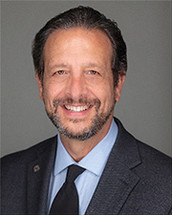
Thomas Brandon, PhD
Thomas Brandon is Director of the Tobacco Research and Intervention Program (TRIP) at Moffitt Cancer Center in Tampa, Florida. He recently completed a 10-year term as Chair of the Department of Health Outcomes and Behavior at Moffitt, and he is Professor of Psychology and Oncologic Sciences at the University of South Florida.
Dr. Brandon has 40 years of research experience focused on the study of factors that maintain tobacco dependence as well as the development of novel tobacco-cessation and relapse- prevention interventions. His research has examined the problem of cigarette smoking and smoking relapse via several different modalities, ranging from basic human laboratory research on smoking motivation to applied research on smoking cessation and relapse prevention in a variety of populations. He is a co-author of Annual Review articles on smoking motivation and relapse/relapse prevention. In the development of interventions, he has concentrated on theory- based behavioral treatments and self-help interventions. The Forever Free ® self-help programs (which include Forever Free, Stop Smoking for Good, and Libre del Cigarrillo) have been validated in multiple randomized controlled trials, and they have been disseminated by NCI and health organizations nationwide. Recently, Dr. Brandon has expanded his research to study the addiction mechanisms and potential clinical utility of electronic cigarettes.
Dr. Brandon served on the American Association for Cancer Research (AACR) Tobacco Policy Committee and has co-authored policy statements for AACR and the American Society of Clinical Oncology (ASCO). He served as President of the Society of Addiction Psychology and Editor of the journal Psychology of Addictive Behaviors. He is Training Co-Director of Moffitt’s NCI-funded postdoctoral training program in behavioral oncology and has trained 20 of his own doctoral students and several postdoctoral fellows.
In 2018, Dr. Brandon received the Joseph W. Cullen Award from the American Society of Preventive Oncology for his contribution to tobacco research, and he was named Moffitt’s W. Jackson Pledger Researcher of the Year.

Vani Simmons, PhD
Vani Simmons is Co-Director of TRIP, Senior Member in the Department of Health Outcomes and Behavior at Moffitt Cancer Center, and Professor of Oncologic Sciences and Psychology at the University of South Florida. Dr. Simmons’s research interests include the development of smoking cessation and relapse-prevention interventions for cancer patients and ethnic minorities.
A resumption of smoking among cancer patients can result in numerous adverse health consequences. Thus, Dr. Simmons has conducted research to study smoking relapse among lung cancer and head and neck cancer patients and to test the efficacy of the first targeted smoking relapse-prevention intervention for cancer patients. Dr. Simmons also leads the NCI Cancer Moonshot Cessation Initiative to build the smoking cessation infrastructure at Moffitt Cancer Center. Dr. Simmons has chaired the Cancer Forum of the American Public Health Association, served on the ASCO Cancer Prevention Committee, Chaired the ASCO Tobacco Subcommittee, and was a chapter lead for the seminal 2022 NCI monograph on treating smoking in cancer patients.
Dr. Simmons also has a strong research interest in reducing racial/ethnic health disparities and forging community-academic partnerships. Given the relative lack of evidence-based smoking cessation interventions for Spanish-speaking smokers, Dr. Simmons has conducted research on the development of culturally appropriate smoking relapse-prevention intervention materials for Hispanic smokers, including co-leading the largest randomized controlled trial to date with Spanish-speaking smokers.
Questions & Answers
For many years, we developed and tested traditional face-to-face smoking cessation interventions involving group or individual cessation counseling. But we realized that we were not reaching the majority of smokers who were uninterested or unable to attend such intensive counseling sessions. This insight led us to develop a more comprehensive self-help approach that aims to deliver the validated cognitive-behavioral content of counseling via a modality that can reach more individuals who would like assistance with quitting smoking. We refer to our approach as “extended self-help,” because we deliver the intervention materials (booklets and pamphlets) over the course of 12 to 18 months rather than at one time as traditional self-help programs do. We began with a focus on relapse prevention, delivering the intervention materials to individuals who had recently quit smoking but who continued to struggle to maintain tobacco abstinence. This led to work with some special populations who were at high risk for smoking relapse, including pregnant and postpartum women and cancer survivors. We then modified our materials to incorporate initial smoking cessation and then tested English- and Spanish- language versions in nationwide clinical trials, which led to the two interventions newly disseminated by EBCCP. The fundamental goal of our research is to maximize the population impact of smoking cessation by balancing reach and effectiveness. That is, we are trying to preserve the effectiveness of face-to-face counseling while expanding reach via self-help materials that can be easily disseminated and are cost-effective. Thus, we are truly excited to partner with EBCCP on their dissemination.
The cultural tailoring is key. For example, our Spanish-language program (Libre del Cigarrillo) was modeled after the original English program (Stop Smoking for Good), but it was not simply a literal translation. Instead, we employed a systematic approach to “transcreate” the program into a form that is culturally appropriate across diverse Hispanic/Latino populations. This process included focus groups, interviews, and learner verification sessions with individuals who were at various points in the smoking cessation process. Our goal was to ensure that the intervention content, its language, and its look and feel were all tailored to the needs and preferences of this population. In the original study, because the concept of “familia” emerged as critical from this process, we included “familia” in the title of the program and added a booklet to be shared with family members and friends (Para Mis Familiares y Amigos) about the roles they could play to support the person trying to quit smoking.
The featured interventions were designed to deliver materials to clients monthly over an 18- month period. This is one of the critical advances of our approach over traditional self-help. Although our approach is much easier to implement compared with face-to-face smoking cessation counseling, it does require some action from the implementing organization to deliver the intervention materials over time. That is, the organization needs to mail or email the correct materials to each participant each month. We have found that some organizations instead simply hand out relevant booklets to clients based on their current concerns. For example, they may give Booklet 3 (Smoking and Weight) to a client concerned about gaining weight, and Booklet 6 (Stress and Mood) to a client who relies upon smoking to deal with stress. Although this approach may be beneficial, the intervention has not been validated for use in this manner. It was intended to be a comprehensive 18-month program with monthly delivery of new materials. Thus, for maximum benefit, we encourage organizations to disseminate the materials in this extended manner.
We are continuing to fine-tune these interventions, particularly the Spanish-language versions, as there are very few options available to smokers who require or prefer such interventions in Spanish. We also recently developed a similar extended self-help intervention for individuals who both smoke cigarettes and vape e-cigarettes. Finally, we are developing smartphone apps as an alternative means to deliver our extended self-help content. We have even utilized augmented reality technology in some of these apps to help users cope with urges when faced with smoking triggers.


